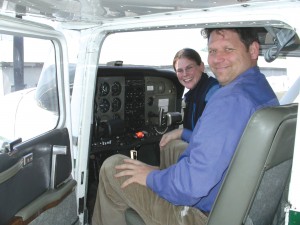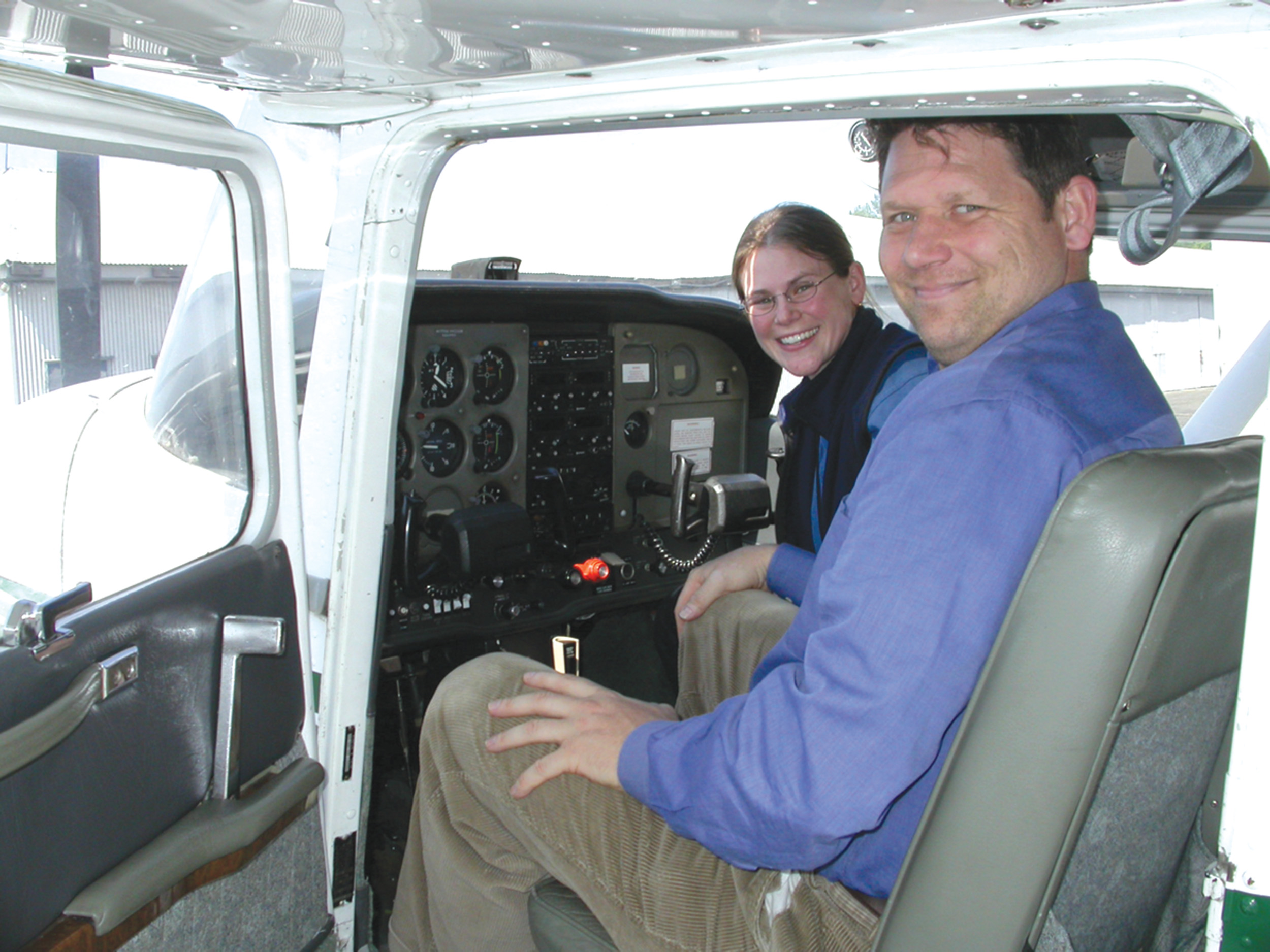By Terry Stephens

Christy Helgeson, assistant chief flight instructor at Wings Aloft, is teaching Rob Drake, a computer and flight instructor at Aviation High School, to fly. He hopes to qualify soon for his private pilot’s license, joining a small group of deaf pilots.
Born deaf, Rob Drake can’t hear anyone tell him he can’t reach his goals, including learning to fly in a world where he can’t hear his plane’s engine, can’t hear his passengers and can’t hear his radio. That’s a scenario too scary for most hearing people to contemplate, living in a world where they’re so dependent on sounds, voices and audible warning signals.
But to Drake, who has never known sound, it’s a comfortable, quiet world in which he’s learned to function exceptionally well. At 35, he’s found his “dream job,” he said, as the computer system and website guru at Aviation High School in south Seattle, where he also instructs students as they practice ground flying with Microsoft Flight Simulator in the school’s computer lab.
Now the holder of a student pilot’s license, he’s in the midst of earning his private license from the FAA, which would make him the first deaf pilot certified in the state of Washington. Nationally, just over 100 deaf pilots have earned their private license, according to the International Deaf Pilots Association, which also reports that 12,300 of the nation’s 13,000 airports don’t have control towers, making them accessible for deaf pilots who usually fly VFR and can’t communicate by radio.
Those who know Drake, including his flight instructor for the past several months, Christy Helgeson at Wings Aloft on Boeing Field, are impressed by his determination to reach his goals in life. But even more impressive, she said, is his exuberant spirit. Drake seems to have the power of positive thinking, which shatters obstacles in his path like a sonic boom. An obviously well educated man, there’s one thing Drake has never learned—the meaning of “can’t.”
“People shouldn’t be surprised that deaf people can fly,” Drake said.
Yet he knows why they are; they find it difficult to believe anyone can fly without being able to hear, as well as see and feel, what’s going on. It’s his keen awareness of his surroundings, sharp-eyed observation and sensitivity to vibration and movement that make the difference for him, he said.
“Because I was born deaf, my other senses were heightened,” he said. “Early in my life, I was so sensitive to vibrations I could call my dog from upstairs in my home and feel and sense his movements. By vibrations, I could tell where he was in the house as he came to me. That’s why I can sense subtle changes in a plane’s engine vibrations.”
Learning to communicate with the rest of his quiet world began early.
“I began learning sign language as a baby,” he said. “The visual part of the brain begins developing earlier than the speech part.”
An added advantage for Drake is that he speaks well, blending conversation with sign language, lip reading, grins and excited arm waving to communicate. That’s his usual manner, in the air as well as in the classroom, where he regularly advises students who are flying by computer to “lift your nose” or “reduce power.”
Fewer than 10 percent of the people who are born deaf have learned to speak, Drake said, since they have had no experience with speech compared to those who become deaf later in life.
“Growing up, I realized I lived in a speaking world and that I needed to learn to speak to function well and to have more opportunities,” he said. “As a kid I tried not to let my speech and actions show I was different; I didn’t want anyone to single me out. Not everyone has that ambition, of course.”
Now 35, Drake remembers how determined he was to learn to speak as he grew older. Like any child his age, he admits, he “hated the speaking training he endured daily with a speech therapist.”
“You know, put your fingers on your throat and learn different vibrations as you speak,” he said. “But I had an opportunity that all deaf people don’t have and I wanted to take advantage of it.”
He’s also proud of the role his younger sister played in his life. She followed him everywhere, he said, correcting everything he said.
“She never stopped talking to me,” he said.
As for the publicity he’s received about his flying abilities, he’s grateful for anything that heightens the image of deaf people’s capabilities in the public mind. But he’s also sad because “people’s interest in his accomplishments reveals a deeper problem.”
“They assume someone who can’t hear can’t fly, or succeed in other fields,” he said.
Drake found that his interest in computers came naturally. He grew up programming computers, using them for communicating, including chatting over the Internet. He was a pre-med student before focusing on a technology career, a field he pursued in earnest after earning a BS in chemistry and biology and a master’s in critical and creative thinking.
A south Seattle resident, he and his wife, Marja Brandon, moved to Seattle five years ago with their children, to start Seattle Girls’ School, modeled on the Boston Girls’ School where she had taught before. D.J. is now 15; Jazz is 12, Anja is 11 and Peace is 8.
Drake found his own teaching position with Aviation High School through one of his friends, a floatplane pilot whose daughter attended Seattle Girls’ School. The friend’s mention of the high school’s aviation-themed curriculum was all it took to connect Drake with the school’s principal, Reba Gilman. The day he met her, he was hired “on the spot.”
Soon after he began teaching flying to the students last fall, using his lessons from ground school and the Microsoft “flying” software, he began his own flight instruction at Wings Aloft.
“I’ve always wanted to fly,” he said. “My dad was a pilot but he didn’t talk much about it. I think he was afraid I’d get excited about flying and then find I couldn’t do it because of my limitations. When he found out recently I was going to become a pilot, he was overwhelmed with pride. He knows when I focus on an ambition I don’t let anything get in the way. Now he talks a lot about his own flying.”
Drake is meticulous in his planning for flights and in his training, saying he doesn’t want to be “the deaf guy who makes a big mistake,” while leading the way for those who will follow him.
“I know I’ll make some mistakes, like all pilots do, but I don’t want that label on me,” he said.
Before flying into Boeing Field, one of the Northwest’s busiest airports, he sets up an orbiting point outside of the traffic pattern, over Seward Park east of the field, waiting for a light signal from the tower. Then he’ll radio his approach information. To earn his private license, he’ll need to pass tests that prove he has alternative communication methods that will substitute for two-way radio talk. He will also have to demonstrate his ability to handle power-off emergency procedures.
“Regardless if you’re deaf or if you’re a paraplegic—whatever your limitation—maybe there’s a lot more you can do in life than what you may first think,” said Helgeson, expressing a lesson she’s learned from working with Drake.
She got involved with Drake through a mutual friend, Peter Morton, co-owner of a Cirrus SR20 aircraft leased to Wings Aloft and a board member of the Seattle Girls’ School, as well as the board of The Museum of Flight.
“Rob emailed me that he’d like to learn to fly, but he said it was important that I would also be an ally, not just an instructor,” she said. “He knew he was going to have a lot of things to overcome and he would need someone dedicated to helping him reach his goals. That meant discussions with the FAA staff and developing my own approach for training someone who couldn’t hear me. I created a whole new way of teaching.”
Helgeson knew she’d have to adjust to training a deaf student. Since she’d never known anyone who was deaf before, she had to learn as she went along.
“You have to look right at him for his lip reading and I couldn’t have my hands in front of my face,” she said. “In the air, I couldn’t give him the usual verbal feedback on what he was doing, so I used a white board for notes, flip books for pictures and a written check-list. I also had to think about how an airplane feels during flight and communicate that to him. It was very challenging for me but it’s made me a better instructor.”
She also made her own decision to learn sign language.
“It was one more tool in my toolkit to help him,” she said. “I know about 200 words now. It’s really worked out well.”
Drake has to be able to respond to flying experiences and unexpected incidents as well as a pilot with hearing, so Helgeson has worked with him on a variety of emergency procedures. To simulate engine failure, for instance, she pulls back on the throttle suddenly.
“He’ll feel the engine vibrations change and see the drop in rpm and oil pressure on his gauges,” she said. “Going into a stall, he’s aware of the pitch; the controls become very mushy and he’ll feel the (aerodynamic) buffeting. He can’t hear the stall alarm in the plane, but he can feel the stall. That’s even better because sometimes the stall indicator doesn’t always work. He just has to demonstrate he can do all the things any pilot would do to get their license. We’re working with the FAA in Okalahoma City and here at Boeing Field, where they’ve been very supportive.”
Drake’s future goals mean more challenges, but those who know him expect he will accomplish them. First, he wants to earn his private pilot’s license. Second, he wants to earn permission from the FAA to use high-intensity light-gun signals to communicate with airport tower crews. The red, green and amber light sequences are already used to exchange messages with pilots in aircraft without radios.
“It’s very important to me that I pass, or fail, because of my skills as a pilot, not because of someone’s attitude about deaf pilots,” Drake said.
He’s set another goal, too, for this summer—flying with Helgeson to the nation’s largest air show, EAA AirVenture at Oshkosh, Wis., July 25 to 31.
“We’ve both been invited to make a presentation at the show, but to make the trip economically viable, we need an angel donor to loan us an aircraft for the flight,” Drake said. “Maybe there’s someone out there who would like to help.”
Rob Drake can be contacted at robertdrake@techworksnw.com, and Christy Helgeson at chelgeson@wingsaloft.com. For information about the International Deaf Pilots Association, visit [http://www.deafpilots.com].











